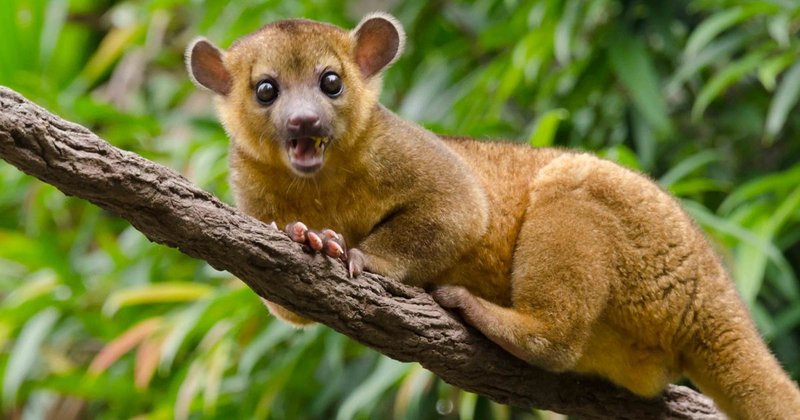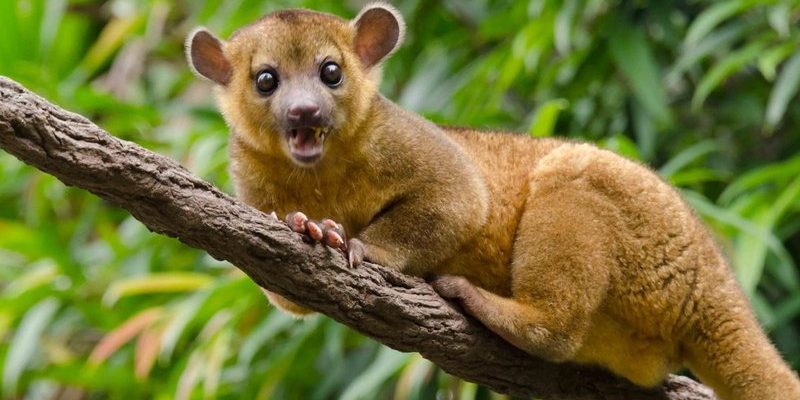
Kinkajous are often called “honey bears” for their love of sweet treats and their bear-like appearance. They’re nocturnal, which means they come alive at night to forage for fruits, nectar, and even insects. But like many animals, their natural habitat is being threatened by deforestation, poaching, and climate change. Understanding the status of kinkajous and their conservation needs is not just about saving an adorable species; it’s also about maintaining the delicate balance of our ecosystems.
Understanding the Kinkajou: What Makes Them Unique?
Kinkajous are fascinating creatures, often described as the “little cousins” of raccoons. They belong to the Procyonidae family, which also includes raccoons and coatis. Their unique features include a long, prehensile tail that acts like a fifth limb. This tail helps them navigate through the canopies of trees, making them excellent climbers.
Another interesting aspect of kinkajous is their diet. They are frugivores, meaning they primarily eat fruits, but they also have a sweet tooth for nectar—hence the nickname *honey bear*. Their role as pollinators is crucial. When they visit flowers for nectar, they transfer pollen from one bloom to another, helping plants reproduce. This delightful relationship showcases the importance of kinkajous in their ecosystem.
But their charm doesn’t end with their eating habits. Kinkajous have a playful, social nature and often live in family groups. You might find them grooming each other or playfully tumbling around in trees, making them a joy to observe in their natural habitat. Understanding these quirks helps highlight why conservation efforts are so important.
What is the Conservation Status of Kinkajous?
The conservation status of kinkajous is classified as “Least Concern” by the International Union for Conservation of Nature (IUCN). However, this doesn’t mean they’re entirely safe. While they’re still relatively widespread in their native habitats, they face significant threats that could lead to declines in their populations.
One major threat is deforestation, primarily driven by agriculture and logging. As trees are cut down, kinkajous lose their homes and food sources. This habitat fragmentation not only isolates populations but also makes it harder for them to find mates, impacting their future survival.
Poaching, often for the exotic pet trade, poses another challenge. While it’s illegal in many areas, the demand for kinkajous as pets means that some are taken from the wild. These practices disrupt their natural behaviors and can lead to declining numbers in the wild. So, while kinkajous aren’t currently endangered, their future is precarious if these issues go unaddressed.
The Role of Habitat in Kinkajou Survival
Kinkajous thrive in humid tropical forests. These forests offer dense canopies that provide shelter and abundant food sources. Sadly, as more trees are cut down, the remaining trees become fragmented, making it difficult for kinkajous to find enough food and mates.
Restoration of their habitats is crucial for their survival. Organizations working in conservation often focus on replanting trees and creating protected areas. These efforts help ensure that kinkajous can continue to thrive in their natural environment. Ecotourism can also play a role, providing both income for local communities and a reason to preserve these beautiful habitats.
Additionally, protecting kinkajou habitats helps countless other species. The rainforests they inhabit are home to diverse wildlife, and when we focus on saving one species, we end up benefiting many others. This interconnectedness is another reason why conservation efforts are essential.
Conservation Efforts: What’s Being Done?
Numerous organizations and conservation groups focus on protecting kinkajous and their habitats. These initiatives range from creating wildlife corridors to educating local communities about the importance of preserving biodiversity.
One successful approach is establishing protected areas where legal logging and hunting are restricted. By creating sanctuaries, kinkajous and other wildlife can find safe havens to live and breed without the threat of human encroachment. Some groups also work to involve local communities in conservation. Educating residents about the ecological value of kinkajous can inspire support for protecting their habitats.
Moreover, sustainable practices in agriculture can help minimize deforestation. Encouraging farmers to use agroforestry techniques—growing crops alongside trees—can provide food and income while preserving their natural environment. This win-win situation is vital for the future of kinkajous and other wildlife.
What Can You Do to Help Kinkajous?
You might wonder how you can help kinkajous even if you’re not directly in the rainforest. Here are a few simple steps you can take:
- Support Conservation Organizations: Donate or volunteer with organizations focused on wildlife protection.
- Educate Others: Share information about kinkajous and their conservation needs with friends and family.
- Choose Sustainable Products: Opt for products made from sustainably sourced materials to reduce deforestation.
- Be a Responsible Tourist: If you visit areas where kinkajous live, participate in ethical wildlife tourism that supports local conservation efforts.
Every little effort counts. By spreading awareness and supporting conservation, you contribute to a brighter future for kinkajous and their habitats.
Future Outlook for Kinkajous
The future of kinkajous is uncertain, but with continued awareness and action, there’s hope. They may not be endangered yet, but their situation can change rapidly if threats like deforestation and poaching continue unchecked.
Looking ahead, it’s crucial to keep the conversation going about the importance of preserving these unique creatures. Each of us has a role to play in conservation, whether it’s through direct action, education, or simply spreading the word.
With the combined efforts of local communities, conservation organizations, and informed individuals like you, we can ensure that kinkajous continue to swing through the trees for generations to come.
Though it may take time, positive change is possible when we work together. So, let’s celebrate these charming little creatures and commit to protecting their future. Together, we can make a significant difference.

